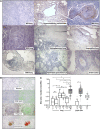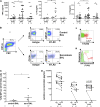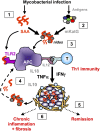Serum amyloid A regulates granulomatous inflammation in sarcoidosis through Toll-like receptor-2
- PMID: 19910611
- PMCID: PMC2822973
- DOI: 10.1164/rccm.200905-0696OC
Serum amyloid A regulates granulomatous inflammation in sarcoidosis through Toll-like receptor-2
Abstract
Rationale: The critical innate immune mechanisms that regulate granulomatous inflammation in sarcoidosis are unknown. Because the granuloma-inducing component of sarcoidosis tissues has physicochemical properties similar to those of amyloid fibrils, we hypothesized that host proteins capable of forming poorly soluble aggregates or amyloid regulate inflammation in sarcoidosis.
Objectives: To determine the role of the amyloid precursor protein, serum amyloid A, as an innate regulator of granulomatous inflammation in sarcoidosis.
Methods: Serum amyloid A expression was determined by immunohistochemistry in sarcoidosis and control tissues and by ELISA. The effect of serum amyloid A on nuclear factor (NF)-kappaB induction, cytokine expression, and Toll-like receptor-2 stimulation was determined with transformed human cell lines and bronchoalveolar lavage cells from patients with sarcoidosis. The effects of serum amyloid A on regulating helper T cell type 1 (Th1) granulomatous inflammation were determined in experimental models of sarcoidosis, using Mycobacterium tuberculosis catalase-peroxidase.
Measurements and main results: We found that the intensity of expression and distribution of serum amyloid A within sarcoidosis granulomas was unlike that in many other granulomatous diseases. Serum amyloid A localized to macrophages and giant cells within sarcoidosis granulomas but correlated with CD3(+) lymphocytes, linking expression to local Th1 responses. Serum amyloid A activated NF-kappaB in Toll-like receptor-2-expressing human cell lines; regulated experimental Th1-mediated granulomatous inflammation through IFN-gamma, tumor necrosis factor, IL-10, and Toll-like receptor-2; and stimulated production of tumor necrosis factor, IL-10, and IL-18 in lung cells from patients with sarcoidosis, effects inhibited by blocking Toll-like receptor-2.
Conclusions: Serum amyloid A is a constituent and innate regulator of granulomatous inflammation in sarcoidosis through Toll-like receptor-2, providing a mechanism for chronic disease and new therapeutic targets.
Figures










References
-
- American Thoracic Society (ATS), European Respiratory Society (ERS), World Association of Sarcoidosis and Other Granulomatous Disorders (WASOG). Statement on sarcoidosis. Am J Respir Crit Care Med 1999;160:736–755. - PubMed
-
- Iannuzzi MC, Rybicki BA, Teirstein AS. Sarcoidosis. N Engl J Med 2007;357:2153–2165. - PubMed
-
- Zissel G, Prasse A, Muller-Quernheim J. Sarcoidosis: immunopathogenetic concepts. Semin Respir Crit Care Med 2007;28:3–14. - PubMed
-
- Moller DR, Forman JD, Liu MC, Noble PW, Greenlee BM, Vyas P, Holden DA, Forrester JM, Lazarus A, Wysocka M, et al. Enhanced expression of IL-12 associated with Th1 cytokine profiles in active pulmonary sarcoidosis. J Immunol 1996;156:4952–4960. - PubMed
Publication types
MeSH terms
Substances
Grants and funding
LinkOut - more resources
Full Text Sources
Other Literature Sources
Medical
Miscellaneous

